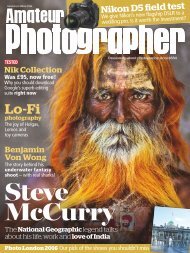You also want an ePaper? Increase the reach of your titles
YUMPU automatically turns print PDFs into web optimized ePapers that Google loves.
STAR SANCTUARIES<br />
Protecting<br />
America’s<br />
LAST DARK SKIES<br />
Few stargazing sites deliver like America’s national parks.<br />
But even these places are under threat. by Eric Betz<br />
A smattering of crisp white clouds lingers<br />
west of Grand Canyon National Park.<br />
And as the desert Sun sets, smoke from a far-off fire turns the sky as<br />
red as the surrounding Supai sandstone. Venus slowly emerges from<br />
behind the clouds like a beacon of the night. Jupiter and the evening<br />
star push toward the horizon, racing the crescent Moon in a perfect<br />
isosceles triangle. Their setting leaves an inky black sky bustling with<br />
activity. Faint stray meteors streak at zenith, and satellites crawl across<br />
the sky like ants on their ardent paths.<br />
If you sat here on a moonless night like<br />
this and counted through until dawn, you<br />
could tally thousands of stars.<br />
“The place you are in is special — keep<br />
that in your mind — in contrast to the places<br />
that most of us live,” says International Dark-<br />
Sky Association (IDA) astronomer John<br />
Barentine, who manages the Dark-Sky Places<br />
Program. “Every human being once shared<br />
this experience of looking up into the night<br />
sky and seeing it filled with stars.”<br />
Before the spread of electricity, humans<br />
across the planet knew the stories written<br />
54 ASTRONOMY • JUNE 2016<br />
in the skies. Sitting around smoldering<br />
campfires, people looked to the stars and<br />
relived the tales of their heroes. Now these<br />
experiences are confined to star sanctuaries<br />
like Grand Canyon National Park.<br />
With the nation celebrating a century<br />
since the inception of the National Park<br />
Service, the agency has recommitted itself<br />
to protecting a resource overlooked by<br />
many in America — the night sky.<br />
Forgotten heroes<br />
And, as a crowd builds in a darkened<br />
parking lot near Grand Canyon’s Mather<br />
Point, the talk here turns to the greatest<br />
of those ancient heroes — Hercules.<br />
Barentine is guiding a group of parkgoers<br />
on a tour of the night sky. “Imagine with<br />
me that there is the body of a man who’s<br />
kneeling,” Barentine says as he sketches the<br />
figure on the sky in green laser. “His body<br />
is this set of four stars here that’s sometimes<br />
called The Keystone.”<br />
As part of his 12 labors of penance,<br />
Barentine explains, Hercules was forced to<br />
steal the golden apples of the Hesperides.<br />
To get them, our Greek hero — the illegitimate<br />
son of Zeus — adventured in search<br />
of Hera’s secret garden and killed the<br />
dragon that guarded them. That serpent is<br />
now commemorated in the constellation<br />
Draco the Dragon, placed next to Hercules<br />
in the night sky.<br />
“The human brain saw patterns in<br />
those stars. And we translated all of our<br />
human hopes and our fears and our dreams<br />
and our worries onto those stars,” says<br />
Barentine. “The natural night sky inspires.<br />
TYLER NORDGREN






